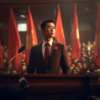President of Sanama: Difference between revisions
No edit summary |
No edit summary |
||
| (13 intermediate revisions by 2 users not shown) | |||
| Line 5: | Line 5: | ||
|arms = File:Sanama_Coat_of_Arms.png | |arms = File:Sanama_Coat_of_Arms.png | ||
|caption = [[Coat of arms of Sanama]] | |caption = [[Coat of arms of Sanama]] | ||
|photo = | |photo = File:Toti Lampa.png | ||
|name = | |name = [[Toti Lampa]] | ||
|date = | |date = 10.XII.1740 | ||
|style = Excellency | |style = Excellency | ||
|residence = [[Pahay Xonutili]], [[Semisa City]] | |residence = [[Pahay Xonutili]], [[Semisa City]] | ||
|appointer = | |appointer = [[Lhusan Nasyonal]] | ||
|term = | |term = Five years | ||
|first = Keysa Nur Pinito Caprici | |first = Keysa Nur Pinito Caprici | ||
|formed = {{unbulleted list|1707|(1679)}} | |formed = {{unbulleted list|1707|(1679)}} | ||
}} | }} | ||
The '''President of Sanama''', formally the ''President of the Union'' (''Xonuti Lanyitali'' in [[Sanaman language|Sanaman]]), is the head of state of [[Sanama]] and commander-in-chief of the armed forces of the union. Tracing its origin to 1679 when the first presidency was formed, the current office was reconstituted in 1707, after having been abolished since 1697. Since the | The '''President of Sanama''', formally the ''President of the Union'' (''Xonuti Lanyitali'' in [[Sanaman language|Sanaman]]), is the head of state of [[Sanama]] and commander-in-chief of the armed forces of the union. Tracing its origin to 1679 when the first presidency was formed, the current office was reconstituted in 1707, after having been abolished since 1697, and given greater powers in a [[1735 Sanaman constitutional referendum|1735 referendum]]. Since the amendments in 1735, the President of the Union is the most prestigeous political office in Sanama, although in the context of a semi-presidential system. The President can appoint and dismiss the Premier, veto legislation and issue decrees. Nomination for the presidency prior to 1735 was limited to persons who were not and had never been members of a political party, and who belonged to organisations within certain sectors of civil society. After 1735 any person meeting the requirements of the constitution can be nominated. | ||
=== See also === | |||
* [[List of heads of state of Sanama]] | |||
[[Category:Government]] | |||
Latest revision as of 18:40, 12 February 2025
| President of Sanama | |

| |
| Coat of arms of Sanama | |

| |
| Incumbent | |
| Toti Lampa | |
| since 10.XII.1740 | |
| Style | Excellency |
| Residence | Pahay Xonutili, Semisa City |
| Appointer | Lhusan Nasyonal |
| Term | Five years |
| Inaugural holder | Keysa Nur Pinito Caprici |
| Formation |
|
The President of Sanama, formally the President of the Union (Xonuti Lanyitali in Sanaman), is the head of state of Sanama and commander-in-chief of the armed forces of the union. Tracing its origin to 1679 when the first presidency was formed, the current office was reconstituted in 1707, after having been abolished since 1697, and given greater powers in a 1735 referendum. Since the amendments in 1735, the President of the Union is the most prestigeous political office in Sanama, although in the context of a semi-presidential system. The President can appoint and dismiss the Premier, veto legislation and issue decrees. Nomination for the presidency prior to 1735 was limited to persons who were not and had never been members of a political party, and who belonged to organisations within certain sectors of civil society. After 1735 any person meeting the requirements of the constitution can be nominated.